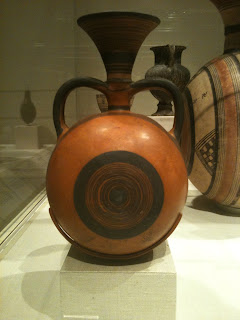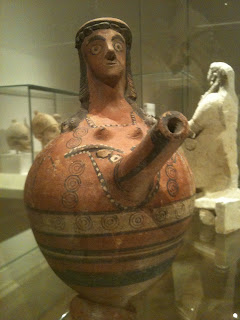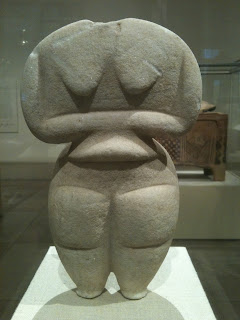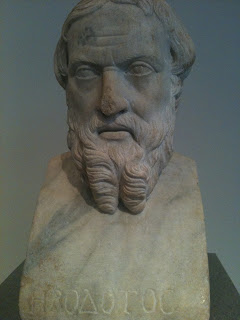Limestone head of a bearded man
Cypriotic, Archaic, early 6th Century B.C.
Said to be from Golgoi
THE CESNOLA COLLECTION
From early bronze age to the end of antiquity
Cyprotic Art
Should I have started my "Live-in" Sessions at the Met chronologically, the Cesnola collection would be the right place to begin. With that I mean, one of the first official collections that the Metropolitan began with.
Luigi Palma di Cesnola 1832-1904
Cesnola was a self-proclaimed General when he was sent as an American consul to the Cyprotic Islands. An opportunist that had been arrested during the war among the States for trying to create mutiny by attempting to lure the regiments troops away to fight under him.
At first he hated being in Cypros, but then he met the English consul and found out that there was an abundance of ancient relics of Greek, Egyptian, Persian and Arabian heritage buried there. Cesnola quickly turned himself into an archeologist and dealer, and later he was looking for a home for his loot.
A home it found, the New York Historical society had made their intentions clear to establish a museum and art Gallery for the public in Central Park in the 1860's.
By 1872 the Museum opened and in 1873 the collection of Cesnola and also the Blodgett paintings (174 European paintings, only 64 is still in the Metropolitans collection, the rest seen as fakes and copies) opened to the general public. But the building as we know it in Central Park did not "finish" before 1902, since then there has been many extensions and changes. Maybe the reason why the building can be a puzzle to go through sometimes.With this collection, Cesnola also managed to wiggle himself in to become the first Director of the Metropolitan Museum from 1879 until his death in 1904.
The Cesnola Collection is now considered the most important and comprehensive of Cypriotic Art.
Terracotta flask
Cypriot, Cypro-Geometric III
Black on Red I
Ca. 850-750 B.C.
Terracotta Jug
Cypriot, Cypro-Archaic II
ca. 600- 480 B.C.
Terracotta trick vase
Cypriot, Cypro-Archaic I
ca. 750-600 B.C.
Said to be from Episkopi
I just had to show you these two vases with female "attributes" Incredible? It feels wonderful to have a quick little giggle while you watch such a serious collection.
Marble anthropoid sarcophagus
Graeco-Phoenician, Classical,
last quarter of the 5th Century B.C.
Simple and few human features, but you still can see it is supposed to be a female sarcophagus with the long locks.
Limestone Herakles
Cypriot, Archaic, ca 530-520 B.C.
Herakles was important to the Cypriotic people, he was the only Greek hero that was accepted by the Gods.
Roman Jewelry
Gold and amethyst earrings and ring
1st century A.D.
This last picture comes out a bit dark so it is hard to see the gorgeous purple amethyst. But, hopefully you can imagine it?
I am reading the book "Rogue Gallery" by Michael Gross right now, a book describing the History of the Metropolitan. Not always to the Metropolitan´s liking. The book is not sold in their shop...
"Cesnola is remembered, if all, as a cultural criminal who looted and pillaged and stole not just objects but an irreplaceable opportunity to learn about the past. On Cyprus, his is considered a rapist who thought his victims lesser beings who didn't appreciate their own culture..." (page 64)
Pretty rough telling about the first Director of our beloved Metropolitan.
"Behind almost every painting is a fortune
and behind that a sin or a crime"
With this I will leave you to continue reading in "Rouges Gallery" More updates to follow:)
With Love
Kristin






















































